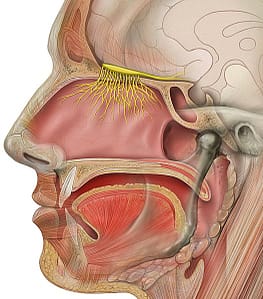
27 Nov a world of the senses of smell and taste
I have found a whole other world in the sense of smell and taste in the past couple of weeks! The first thing I noticed is how delicious food had become, and how disgusting the taste of our water is. It seems to be filled with a whole heap of chlorine and other nasty tasting stuff, which does not inspire the greatest confidence regarding this essence of life. I am going to get a source of filtered or spring water.
A world of fragrance
Then I noticed how much more I was sensing people’s perfumes and other smells in the world. It is so delightful! I never knew the world was so filled with so much invigorating fragrance. Fragrance which can stay in a room after someone has left. Sweet, and citrusy, or deep and musky. It is lush!
So I wanted to know, what is it that allows us to interpret these sensations?
Anatomy of the nose
We have two olfactory bulbs at the top of our noses, near the base of our brains, and these contain a collection of olfactory neurons. The neurons pass through a porous bone in the nose and into the nasal cavity. At this point, odour compounds interact with the olfactory neurons and this is converted into an odour signal that is communicated to the brain. [1]
Olfactory neurons regenerate over time, unlike other neurons in your body, and this is thought to be because they can become damaged by environmental chemicals.
How much effect does smell have on taste?
On many websites which discuss smell and tasting science, they propose that you try the simple experiment of closing your nose while you taste a variety of foods, to see how different your sense of taste is without your nose being involved, like when you have a cold. It becomes quite clear that without your sense of smell, your sense of taste is vastly altered. If you were to try to identify foods without vision or smell you would have a very difficult time trying to identify them!
Evolutionary pressures
The interesting thing is that information from your olfactory neurons and your sense of taste both move to the orbital frontal cortex, where the sensations from your taste receptors and smell receptors are combined to form a perception of a single flavour. This information is then relayed to your tongue, where you perceive the flavour of a particular food. [2]
This is thought to have developed to protect us from foods which are poisonous or spoiled. Sweet or salty foods are usually indicative of foods which are providing us with essential macronutrients, however, foods that are perceived as bitter or sour are often associated with foods that are spoiled or poisonous, and our brain collates this information to protect us from eating dangerous foods. [2]
How do we discriminate between so many odours?
Apparently the mammalian genome has 1000’s of genes encoding for separate odour receptors. Each olfactory neuron has one distinct odour receptor. However, each odour has the capacity to bind to various receptors. So if one odour binds to three receptors, and another odour binds to two of these three receptors but a different third receptor, then the brain interprets these as different smells. [3]
Fascinating stuff!!
References:
1. Dr Delwiche. Basic Anatomy – The olfactory (smell) system. [Internet] 2003 – 2007. [cited 2013 Nov 27] Available from: https://www.tastingscience.info/Explained/Anat.htm
2. Science Daily. A Trained Palate: Understanding Complexities of Taste, Smell Could Lead to Improved Diet [Internet] 2013. Science Daily. [cited 2013 Nov 27] Available from: https://www.sciencedaily.com/releases/2012/05/120530133708.htm
3. Kimball J. The sense of smell. [Internet] 2013 [cited 2013 Nov 27] [Updated 2011 Mar 20] Available from: https://users.rcn.com/jkimball.ma.ultranet/BiologyPages/O/Olfaction.html



No Comments